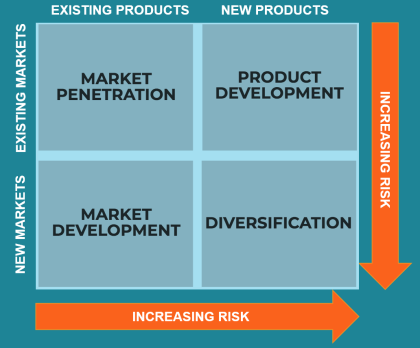Business Growth Strategies: The Ansoff Matrix
Ambitious entrepreneurs understand that in order for a business to be profitable, it’ll have to continually grow and develop over time. Sure, businesses can stay afloat by breaking even on their costs and revenue, but in order to gain traction and expand, business growth strategies are needed.
Enter the Ansoff Matrix, also known as the Product/Market Expansion Grid.
Ansoff Matrix
The Ansoff Matrix is made up of four strategies you can use to grow and expand your business. The matrix is laid out in a way that helps business owners understand their current strategy better, and helps them analyse the risks associated with adopting a new strategy. The idea is that each time you move into a new strategy (horizontally or vertically on the matrix), risk increases. [photo source]

The Ansoff growth matrix is composed of two axes. One which focuses on product, the other on market.
Product prompts you to ask, “What products do I currently offer, and what would I like to offer in the future?”
Market wants you to ask, “What market do I currently serve, and who would I like to serve in the future?”
Four growth strategies
The four Ansoff Matrix growth strategies are as follows:
Market penetration
Market penetration is considered the lowest risk of the four strategies. Market penetration is essential for the success of any retail or hospitality business. Here, you focus on expanding sales of your existing product in your existing market: you know the product works, and you’re familiar with typical clientele.
Market penetration attempts to expand the sales volume of your current products in their current markets, thus increasing your market share. In order to achieve market penetration, you’ll want to draw customers away from your competitors and redirect them to your business. The aim is to encourage brand loyalty and customer retention, perhaps by increasing brand awareness via your marketing strategy, implementing more product/brand promotion, or by having more competitive pricing.
The technique of using distribution channels is one of the most constructive market penetration strategies [1]. This involves opening alternative channels for better access to more customers.
For example, if selling through retail outlets is your primary channel, you can expand into new channels like social media, e-commerce or e-mail outreach, for example. This omnichannel approach enables your business to meet more potential customers, therefore leading to increased brand awareness and more leads.
Product development
Product development is considered slightly more risky as you’re introducing something new to your existing brand. It’s important to note here that product refers to services too, rather than just physical commodities - whatever is being sold is considered a product.
Product development includes expanding your current product line and offering something new for your customers to buy, and revamping and enhancing current products to improve them. The overall goal is to attract new customers within the same market, and to increase the rate at which existing customers buy from your business.
Product development aims to increase turnover by providing more options to the same customers. For example, a burger shop expanding its line to include hot dogs or chips. These products may be obtained by conducting research into consumer demands or undertaking business competitor analyses on companies who already offer your combination of services. Another option is to seek acquisition of rights to produce someone else's product, buying in the product and "branding" it [2].
It’s often much cheaper to keep current customers happy, than to create a fresh marketing strategy that targets a different clientele.
Market development
Marketing development brings an existing product into a new or developed market. It expands the current market to reach more customers, or repurposes the product to suit entirely new customers.
It’s a 2-step process to reach an unexplored market. Begin by conducting extensive market research to identify market segments - small sections of people in a larger population that can be grouped by labels.
Segments can be delineated by things like location, age, income, or industry. It may also include switching from business to customer (B2C) to business to business (B2B), as in acquiring industrial buyers for a good that was previously sold only to households. Or, expanding into foreign markets.
Once your ideal segment has been identified, the next step is to create a targeted promotional strategy. This consists of general marketing and branding strategies for awareness and growth within that segment. This attempts to use the existing product or service to attract new customers. This is done by finding a new use for a product, or by adding new features and benefits to it.
Diversification
Diversification is the riskiest of the four options. This is when you introduce a new, unproven product into an entirely new market. It’s creating a strategy that targets customers who you usually don’t cater to, offering a product that you don’t have experience in.
However, diversification can be extremely beneficial when a brand’s main industry is facing a downturn. When diversification is implemented correctly, it will provide a wonderful boost to brand image and the profit of the company. It also allows a company to make use of excess cash flows [3].
Diversification involves marketing not only the product, but the brand too. This growth plan can be divided into four sub-categories: horizontal diversification, vertical diversification, concentric diversification, and conglomerate diversification.
Horizontal diversification
Horizontal diversification involves buying or developing new products with the aim of selling them to existing customer groups. These new products are often technologically or commercially unrelated to current products but that may appeal to current customers; like the burger shop selling hot dogs. It’s similar to product development, but there are key differences.
Product development targets non-buying customers in existing customer segments, and diversification targets new customer segments with new or existing products. Development focuses on internal strategy and re-thinking elements that already exist. Diversification is to innovate something new, yet it is much riskier and requires more research.
Vertical diversification
Vertical diversification is to moves backwards up the supply chain. Businesses will enter the sector of their suppliers to deliver a complete package type service. For example, if you own a bar, and start operating an off-license too. Or if you own a gym, and start selling dumbbells or protein powders. It’s to sell other relevant materials used in your business, that will appeal to your customers. Large supermarkets like ASDA do this.
Concentric diversification
Concentric diversification expands the line of products with other similar products that come through the same distribution channels. For example, a company that makes basketballs may start selling footballs. This type of diversification is often used by small producers of B2B goods, and allows businesses to reinvest profits into products that can provide better returns than their current line allows, thus creating growth.
Conglomerate diversification
The most diverse and risky type of diversification is a conglomerate strategy. This takes completely new products to completely new markets. What separates this strategy from others is that there is no relation whatsoever to your current product line, customer base, or distribution channels. Businesses choose to do this if a product or service within a certain market is gaining a lot of capital, and they’d like to earn profit from it too, even though they don’t have any links or experience in it. It’s great for recently developed, trending products that are new to the market.
Grow your business with Epos Now
Whether your business is in retail or hospitality, Epos Now have dedicated software systems for your industry. Manage your business with an advanced, yet user-friendly point of sale system that is tailored to your needs, with optional add-ons and features for a fully personalised experience.
With Epos Now’s top-of-the-line POS systems, you can manage things like inventory, sales reports, profit margin, and more. You can also:
- Integrate accountancy and marketing software or a seamless campaign experience
- Create flawless email campaigns using one of the 100+ templates
- Easily add, edit and bundle items to create new revenue opportunities
- Access reports and data from anywhere
- Track sales, profit, and trends in real-time to understand more about your business
- Identify your top-performing products and staff members



